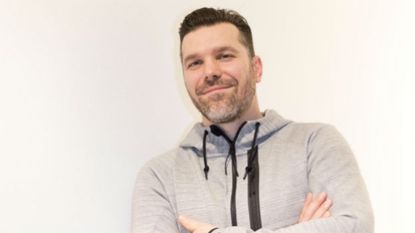Nike's latest running shoe, the Air Zoom Pegasus 31, has been designed with input from national hero Mo Farah. So, T3.com sat down with Rob Dolan, senior design director at Nike Running for one of the most in-depth conversations about running trainers you'll ever read...
Nike's latest running trainers, the Air Zoom Pegasus 31, are a worthy inclusion in our best running shoes to buy in 2014 feature. And so we sat down with the designer to find out about the testing process and what it actually takes to build the best running shoe.
T3: I'm reading here that the Pegasus 31 went through 16,000 test miles. To the average person, that's a huge number. Is that calibre of testing used for all Nike shoes, or is that a unique level of testing for the Pegasus 31?
Rob Dolan: “It's different for every shoe. We do test all of our shoes, because of the complexity of the shoes. It's incredible how much we're changing with new, big innovations. It all depends on the complexity of course, but we wear test extensively. At our research labs, you know, we have athletes on treadmills, pressure plates, so the shoes are already proven out in the lab.
But there's no substitute for real world testing. The perception of the runner is so important, what they feel, what they perceive, the nuances of the shoe. The fitting and the feeling. Human body perception can be incredibly subtle but it makes all the difference, and so it depends on a lot of things. Pegasus was changed a lot though, so we spent lots of time making sure it was really tested.”
T3: Mo Farah was one of the test athletes for the Pegasus. Does knowing that such high-level athletes will be trying out your designs help motivate you, or is it just unwanted pressure? And how much influence did Mo have in the design process?
RD: “We love having Mo. You know you need to deliver for Mo, because he's one of the best athletes in the world. It's definitely not a hindrance. It's really exciting for us, working with him. I mean he trains here on campus, so he's here and he's accessible. He's involved in the very beginning, before we started designing the shoe, you know, what he likes, what could be better.
We listen to other consumers, create a brief based on Mo's feedback. On the current Pegasus, a lot of interaction feedback meant we built the Pegasus new from the ground up – the way it fits, the way it feels. But we tried really hard to retain the Pegasus' essence and feel, but Mo was great. He wear-tested many versions of prototypes, refining, one of the first people to test the shoe.
We met with him during high-altitude training over in Utah, and we were doing a lot of mileage on the shoe. It's instant feedback and we continued to improve. There's nobody quite like Mo, so we wanna make sure the shoe works with him.”
T3: Will you be using Mo in future Nike Running shoe tests?
RD: “He's become our go-to guy for the Pegasus. It's the shoe he loves, the shoe he runs in, and he's arguably the best in the world. We're definitely going to continue with Mo. He will be working on the next versions of the Pegasus.”
T3: The new Pegasus had some strong design changes. What do you think was the most important modification? What are you most proud of?
RD: “I think that even with all the changes, runners are loving it. I mean we changed everything, we changed it quite a bit, but the feedback's been incredible. The sell-through, the feedback, wear-testing it, and at retail, hearing from retailers about what their runners are telling them. That's what makes me most proud. You've made a shoe better than people are loving. I think overall we continued to modernise it, to make a better shoe, and strip away the unnecessary.
"It's lighter, faster, fits better, and we improved the overall heel-to-toe transition, whilst still maintaining Pegasus characteristics. I mean, in terms of history they're one of the longest shoes of all time. We had to make it new, but not alienate anybody. You know, you can't stop innovating – you can make things better, but you can make things worse too. But I'm most happy with the feedback. It's a huge win. We really pushed the shoe forward.”
T3: The design is, at face value, pretty minimalist and unibody as far as shoes go. That makes it a prime candidate for 3D printing. Is there a future where I can walk into a Nike store and print out my own custom shoe right there on the shop floor?
RD: “We're definitely looking at 3D-printing at Nike. You're starting to see it in a lot of industries. I mean we use a lot of 3D printing here during our rapid prototyping phases, to see how different things are starting to play out. But it's out there in the future, and there's plenty of exciting possibilities.”
T3: Tech is advancing at an incredible rate and the testing you guys do in terms of biometrics and simulation is pretty complex. Do you think that sometimes this level of tech-involvement in design maybe complicates a process rather than helps it? I mean we've been making shoes of years…
RD: “So far no. You get a lot of individual feedback regarding the complexity. We know we're making shoes worn by millions of runners. A lot of things you have to average, weigh it all, and make decisions that will work for a lot of runners. We can tune shoes specifically for athletes, almost bespoke. You can learn a lot that way.
Some of our customers are the best athletes in the world, and they do things no one else can do. So we make shoes specifically for them to innovate against, to see if it would benefit other runners. You have to do it all, and have the best people run in shoes, even if it might not work for everybody initially. It is complex, but there's a lot of benefits.”
T3: What's the future for Nike's running shoes? Do you think you'll ever reach a point where you say “That's it. We can't improve the design anymore. It's as good as it gets?”
RD: “[laughs] No way, no way! Sometimes I think it's amazing how we continue to make a shoe better. But there's always new technologies, new ways of manufacturing. They've completely changed the way you think about shoe design. I mean take fly-knit – 30 years ago no one would've dreamed that anyone would be knitting shoes. There's something interesting about that. You can engineer every millimetre, and control every stitch. There's a lot of amazing space in there around engineering surfaces, and you can tune every square inch or millimetre.”


